Patient Complaint Response Letter
[Your Name]
[Your Title/Position]
[Your Healthcare Facility/Organization]
[Address]
[City, State, Zip Code]
[Date]
[Patient's Name]
[Patient's Address]
[City, State, Zip Code]
Dear [Patient's Name],
RE: Response to Your Recent Complaint
I hope this letter finds you in good health. I am writing to acknowledge and address the concerns you raised in your recent complaint about the care and services you received at [Healthcare Facility/Organization]. First and foremost, I want to express our sincere apologies for any inconvenience or distress that you may have experienced during your time with us. We take patient feedback very seriously, and your concerns have been thoroughly reviewed by our team.
We understand the importance of providing high-quality care and ensuring a positive patient experience. Our goal is to always deliver compassionate, competent, and patient-centered care to every individual who walks through our doors. Your feedback helps us identify areas where we can improve and enhance our services.
After a comprehensive investigation into the matter, we have identified the issues you highlighted, and I would like to address each of them individually:
1. [Issue 1]: [Description of the issue and any specific details provided by the patient].
[Response]: We deeply regret the inconvenience caused to you due to [issue 1]. We have taken immediate steps to rectify this situation and have implemented additional training for our staff to ensure similar issues do not arise in the future.
2. [Issue 2]: [Description of the issue and any specific details provided by the patient].
[Response]: We are sorry to hear about your experience regarding [issue 2]. We will be conducting a thorough review of our processes to identify any shortcomings and make the necessary improvements.
3. [Issue 3]: [Description of the issue and any specific details provided by the patient].
[Response]: We apologize for the communication gap that led to [issue 3]. We are committed to enhancing our communication channels to ensure our patients receive timely and accurate information.
Moving forward, we will take proactive measures to prevent similar issues from occurring in the future. Our team will be undergoing additional training to improve their skills, and we will be revising our internal protocols to address the concerns you raised. Furthermore, we encourage our patients to provide feedback regularly, as it plays a vital role in our continuous improvement process.
As a token of our apology, we would like to offer [compensation/gesture of goodwill, if applicable]. Our patient care coordinator will reach out to you shortly to discuss the details.
Once again, I want to extend our sincerest apologies for the inconvenience you experienced. We value your trust in us and hope that you will give us another opportunity to provide you with the quality care you deserve.
If you have any further questions or concerns, please do not hesitate to contact our patient care coordinator at [phone number] or [email address].
Thank you for bringing these issues to our attention. We remain committed to providing excellent healthcare services to our patients.
Sincerely,
[Your Name]
[Your Title/Position]
[Healthcare Facility/Organization]
Formal Patient Complaint Response Letter
Subject: Response to Your Recent Complaint
Dear [Patient Name],
We acknowledge receipt of your complaint dated [Date] regarding your recent experience at [Hospital/Clinic Name]. We sincerely regret any inconvenience or distress caused.
Our team has reviewed the details of your complaint thoroughly. We have identified the issues raised and have taken appropriate corrective measures to ensure similar incidents do not recur.
We value your feedback and commitment to improving our services. Should you require further clarification or wish to discuss this matter, please feel free to contact us directly at [Contact Information].
Thank you for bringing this matter to our attention.
Sincerely,
[Your Name]
[Title]
[Department / Hospital Name]
Heartfelt Apology Patient Response Letter
Subject: Our Apologies Regarding Your Recent Visit
Dear [Patient Name],
We deeply regret the experience you encountered on [Date] at [Hospital/Clinic Name]. Your comfort and care are our highest priorities, and we are genuinely sorry that we fell short during your visit.
Please be assured that we have reviewed the circumstances surrounding your complaint and implemented necessary changes to prevent similar issues in the future. Your concerns have been shared with the relevant team members to improve patient care.
Thank you for bringing this to our attention and allowing us the opportunity to make things right.
Warm regards,
[Your Name]
[Title / Department]
[Contact Information]
Quick and Simple Complaint Response Email
Subject: Response to Your Complaint
Hi [Patient Name],
We have received your complaint regarding your visit on [Date]. We apologize for any inconvenience caused.
Our team has reviewed the matter and corrective measures are in place. Thank you for sharing your feedback.
Best regards,
[Your Name]
[Title / Department]
[Contact Information]
Professional Investigation Outcome Letter
Subject: Outcome of Your Complaint Investigation
Dear [Patient Name],
Thank you for your patience while we investigated your complaint regarding [Specific Issue] on [Date]. Our investigation concluded that [Summary of Findings].
As a result, we have taken the following steps: [List Corrective Actions]. We are committed to maintaining the highest standard of patient care and ensuring such incidents do not occur again.
We appreciate your feedback and invite you to contact us if you have further concerns.
Sincerely,
[Your Name]
[Title]
[Hospital / Clinic Name]
Informal Friendly Patient Response Email
Subject: We Heard You
Hi [Patient Name],
Thanks for reaching out about your experience at [Hospital/Clinic Name]. We’re sorry to hear things didn’t go smoothly.
Our team has taken your feedback seriously and made changes to address the concerns you raised. We hope your next visit will be much better.
Take care,
[Your Name]
[Title / Department]
Provisional / Preliminary Response Letter
Subject: Acknowledgment of Your Complaint
Dear [Patient Name],
We have received your complaint regarding your recent visit on [Date]. This letter serves as an acknowledgment while we conduct a detailed review.
Our team is currently investigating the matter and will provide a full response within [Time Frame]. Thank you for your patience.
Sincerely,
[Your Name]
[Title / Department]
[Hospital / Clinic Name]
Serious Incident Response Letter
Subject: Response to Your Complaint Regarding [Specific Incident]
Dear [Patient Name],
We are taking your complaint about the incident on [Date] very seriously. Immediate measures have been taken to investigate and rectify the situation.
Our senior management has reviewed the case, and corrective actions include [List Measures]. We are committed to ensuring patient safety and quality care.
Thank you for notifying us and helping us improve.
Sincerely,
[Your Name]
[Title / Department]
[Contact Information]
FAQ / Quick Resolution Patient Response Letter
Subject: Your Complaint – Resolution Details
Dear [Patient Name],
We have received your complaint regarding [Issue]. Here are answers to common questions you may have:
- What happened? [Brief Explanation]
- What is being done? [Corrective Actions]
- Who can I contact for follow-up? [Contact Information]
We hope this clarifies your concerns. Your feedback is valuable to us.
Best regards,
[Your Name]
[Title]
[Department / Hospital Name]
What / Why is a Patient Complaint Response Letter
- A patient complaint response letter is a formal or informal communication addressing concerns raised by patients regarding healthcare experiences.
- Its purpose is to acknowledge, investigate, and resolve complaints while maintaining trust and transparency.
- It demonstrates a commitment to patient care, accountability, and service improvement.
Who Should Send a Patient Complaint Response Letter
- Healthcare administrators, patient relations officers, or department heads.
- Doctors or nurses may co-sign for issues related to clinical care.
- The sender should represent the organization professionally and have authority to provide solutions.
Whom Should the Letter Be Addressed To
- The patient who filed the complaint.
- Family members or legal guardians, if authorized.
- In some cases, regulatory or oversight bodies may be copied if required by law.
When to Send a Patient Complaint Response Letter
- Immediately upon receiving a complaint (acknowledgment stage).
- After investigation with a detailed response and corrective actions.
- Following serious incidents or negative patient experiences.
- For recurring complaints or system-wide issues requiring formal communication.
How to Write and Send a Patient Complaint Response Letter
- Begin with acknowledgment of receipt of the complaint.
- Express empathy and apologize if appropriate.
- Detail findings and steps taken to address the issue.
- Maintain a professional tone; informal style may be used for friendly communication.
- Choose delivery mode: printed letter for formal complaints, email for faster response.
Requirements and Prerequisites Before Sending
- Full documentation of the patient complaint.
- Investigation results and corrective action plans.
- Contact details of patient and relevant department.
- Approval from senior management or compliance officer if needed.
Formatting Guidelines for Patient Complaint Letters
- Length: 1–2 pages for formal letters; concise for emails.
- Tone: professional, empathetic, or friendly depending on situation.
- Structure: subject, greeting, acknowledgment, explanation, actions, closing.
- Include attachments if relevant (investigation summary, follow-up forms).
- Use clear language avoiding medical jargon unless necessary.
After Sending / Follow-up Actions
- Confirm the patient received the letter.
- Schedule follow-up if additional action or meeting is required.
- Monitor resolution effectiveness and record feedback.
- Update patient records and internal tracking systems.
Pros and Cons of Sending a Patient Complaint Response Letter
Pros:
- Builds patient trust and satisfaction.
- Demonstrates accountability and responsiveness.
- Helps prevent escalation to regulatory authorities or legal action.
Cons:
- Time-consuming if investigations are complex.
- Risk of miscommunication if poorly written.
- May generate further inquiries or complaints requiring ongoing attention.
Compare and Contrast with Other Patient Communication
- Compared to informal phone calls, letters provide a documented record.
- Compared to internal incident reports, letters are patient-facing and clarify actions taken.
- Alternatives include in-person meetings or follow-up emails; letters ensure professionalism and traceability.
Tricks and Tips for Effective Patient Complaint Letters
- Respond promptly to show concern.
- Use clear, empathetic language.
- Personalize letters with patient name and specific issue details.
- Outline actionable steps taken to resolve the complaint.
- Keep a copy for internal records and follow-up.
Common Mistakes to Avoid
- Ignoring or delaying the response.
- Using defensive or dismissive language.
- Failing to address all points raised in the complaint.
- Overloading with technical medical terms or excessive details.
- Not offering contact for follow-up or additional support.
Elements and Structure of a Patient Complaint Response Letter
- Subject line: Clear reference to complaint or incident.
- Greeting: Personalized to patient.
- Acknowledgment: Confirm receipt of complaint.
- Empathy/Apology: Express regret or understanding.
- Investigation Findings: Brief summary.
- Corrective Actions: Steps taken to resolve issue.
- Next Steps: Contact info, follow-up instructions.
- Closing: Professional and courteous.
- Attachments: Relevant documents or forms.
Does it Require Attestation or Authorization
- Typically, no attestation is required unless for legal or insurance purposes.
- Signature of authorized department representative is recommended.
- Letterhead of hospital/clinic adds credibility.

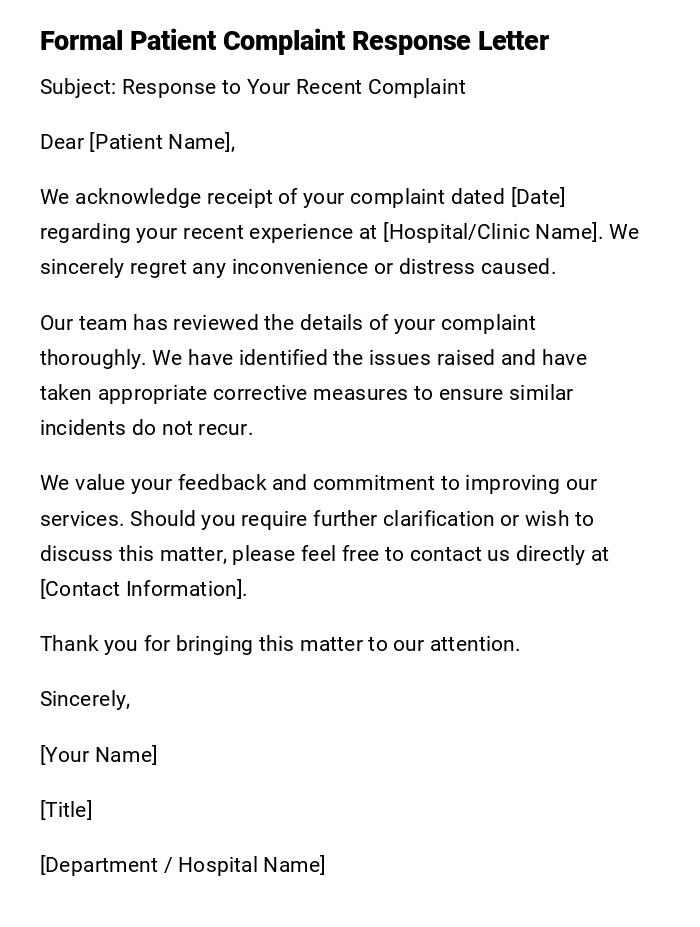
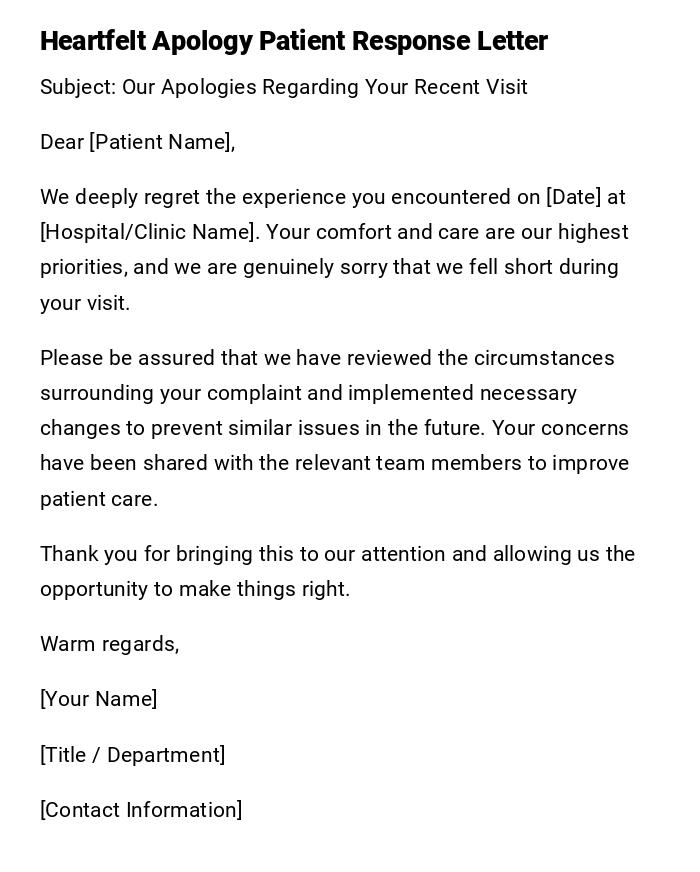
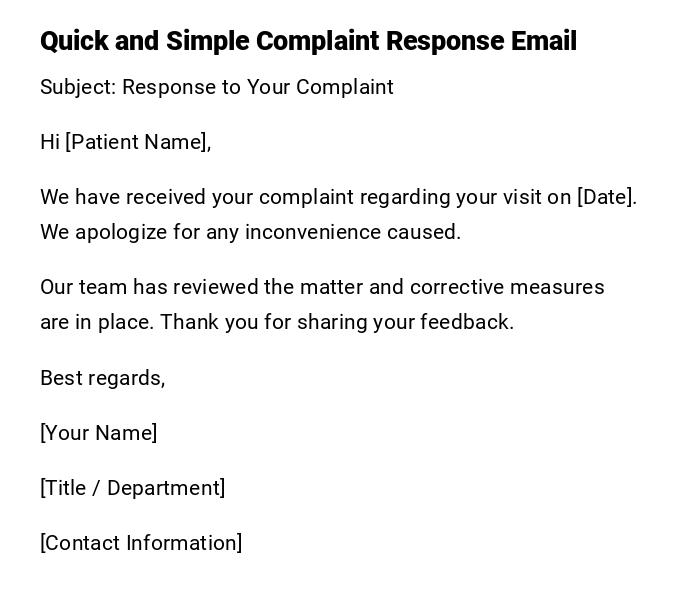
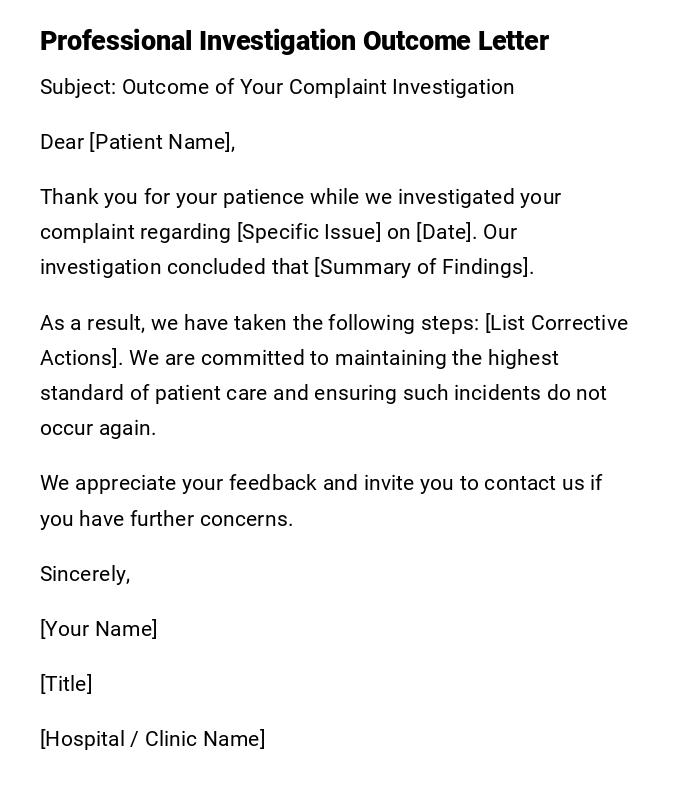
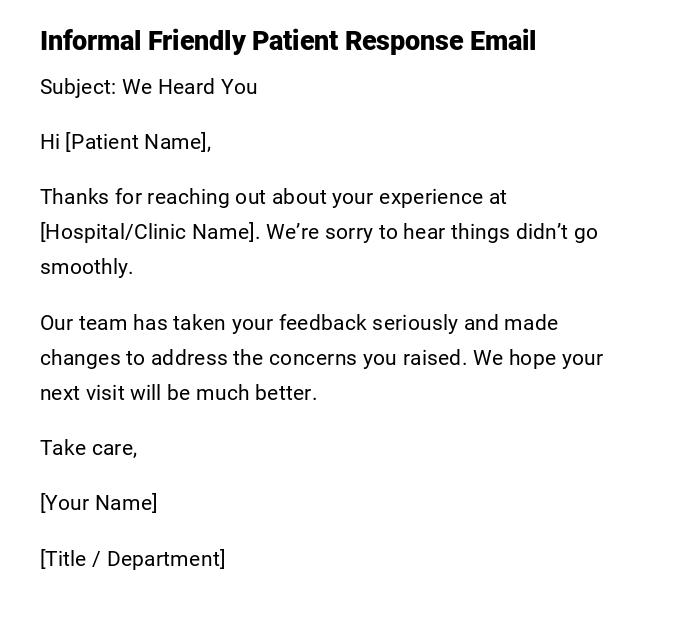
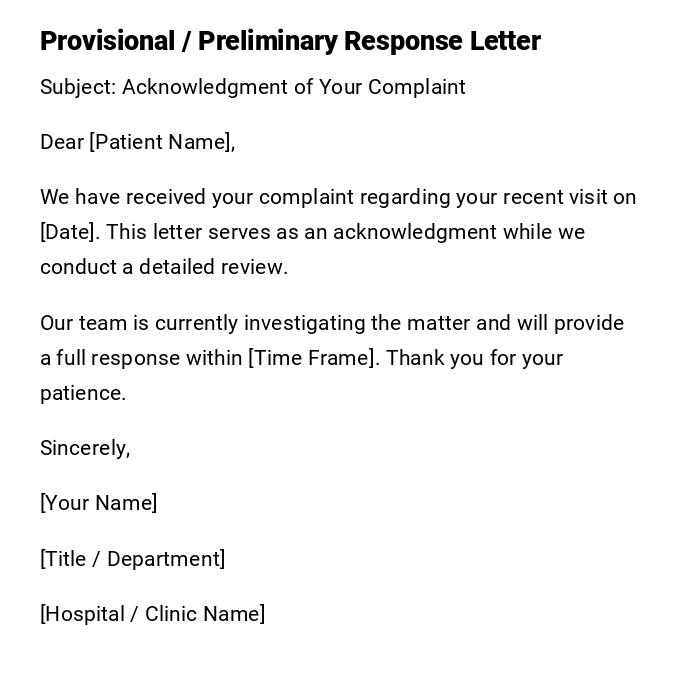
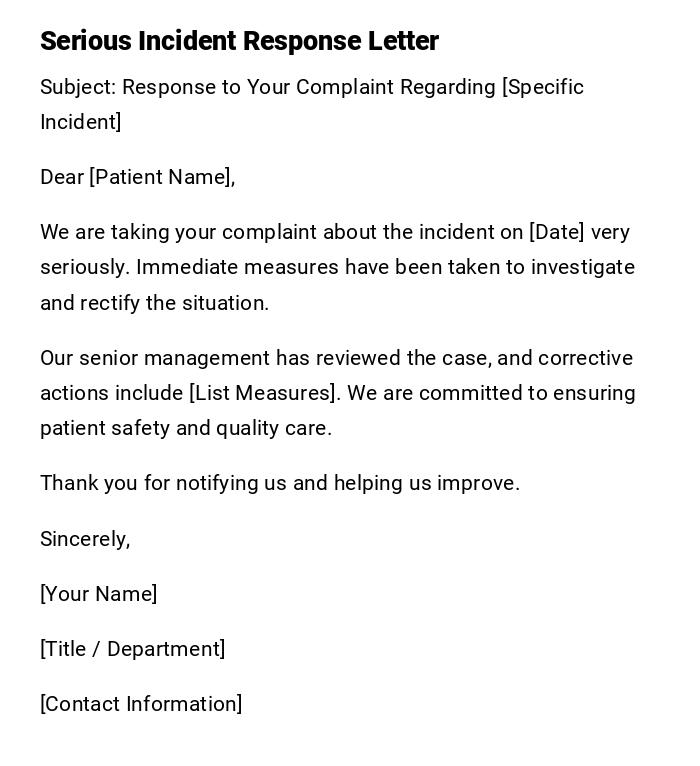
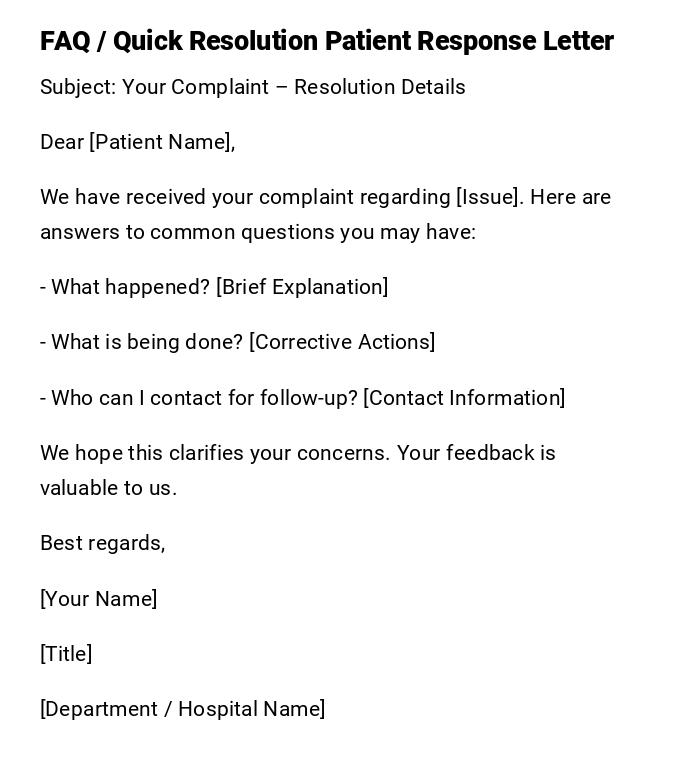

 Download Word Doc
Download Word Doc
 Download PDF
Download PDF